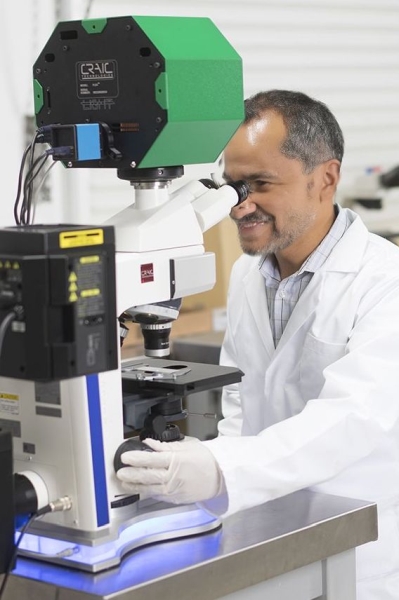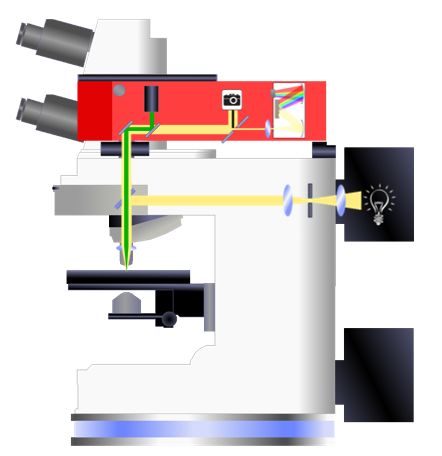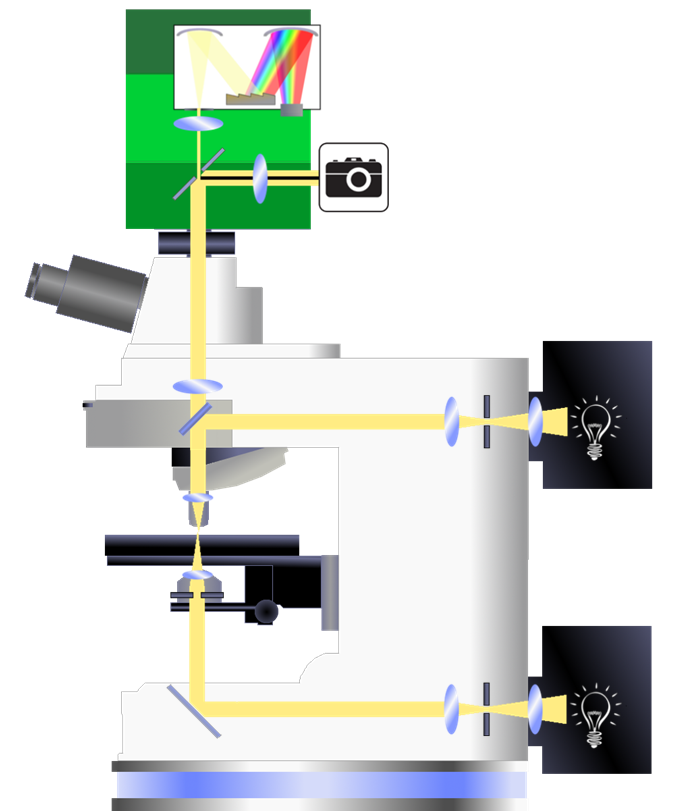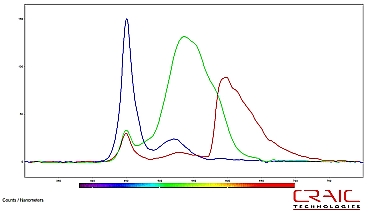Unlock Advanced Capabilities with Microscope Spectroscopy!
Transform your basic optical microscope into a powerful analytical tool with spectroscopy. Optical microscopes, common in laboratories, can be upgraded to perform advanced functions by integrating them with a spectrometer. This enhancement allows for the measurement of various spectra—transmission, reflection, fluorescence, and other optical emissions—from a much smaller sampling area compared to traditional bench-top spectroscopy tools.
Microscope spectrophotometers (or microspectrophotometers or simply MSP) are designed to measure UV-VIS-NIR spectra of microscopic samples or small areas of larger objects. Unlike standard spectrophotometers that analyze samples around 1 x 1 centimeters in size, microspectrophotometers can measure areas as tiny as 1 x 1 micrometers, which is smaller than the thickness of a human hair.
The 508 PV™ microscope spectrophotometer, a modular head unit from CRAIC Technologies, can be installed on the phototube port of most upright microscopes, adding robust spectroscopy capabilities. With this upgrade, you can quickly and non-destructively obtain high-quality spectra from sub-micron samples.
As shown in the accompanying diagram, the MSP head unit attaches to the microscope's photoport. The spectrometer then measures light collected by the objective and focused onto the spectrophotometer entrance aperture. Whether the light is transmitted through, reflected from, or emitted by the sample, the calculations are based on the light intensity measured.
Beyond measuring UV-VIS-NIR spectra in microscale sampling areas, microspectrophotometers can also perform microspot thin film thickness and colorimetry measurements. When combined with motorized stages, these instruments can create hyperspectral data cubes with various types of spectra. Due to their versatility, MSPs are used in a wide range of research and industrial fields, unlocking new potential for microscopic analysis. Enhance your microscope today with CRAIC Technologies' advanced spectrophotometry solutions!
Raman spectroscopy with your microscope!
Optical microscopes are standard in many laboratories, typically serving as magnifying tools to enhance sample visibility. However, with CRAIC Technologies' innovative enhancements, including a laser and a Raman spectrometer integrated through an advanced optical interface, these microscopes can do so much more!
CRAIC Raman spectrometers are specifically designed for micro Raman spectroscopy of microscopic samples or tiny areas within larger objects. While a standard Raman spectrometer measures samples around 1 x 1 centimeters, the Raman microspectrometer can measure samples as small as 1 x 1 micrometers—much thinner than a human hair. The Apollo Raman systems are modular units that attach to upright optical microscopes, adding powerful micro Raman spectroscopy capabilities. With CRAIC Technologies' products, you can rapidly and non-destructively acquire high-quality Raman spectra from sub-micron samples with ease.
As illustrated, the Apollo Raman module integrates seamlessly with the frame of an upright optical microscope. This module includes lasers, a Raman spectrometer, and integration optics. The laser illuminates the sample, and the Raman spectrometer measures the light collected by the objective and focused onto the spectrometer's entrance aperture.
CRAIC Raman microspectrometers offer even more versatility. They can be configured to measure UV-VIS-NIR microspectra™ in transmission, reflectance, fluorescence, and photoluminescence. Additionally, they are capable of microspot thin film thickness and colorimetry measurements.
With CRAIC Technologies, elevate your microscope’s functionality and unlock advanced analytical capabilities that go far beyond simple magnification.
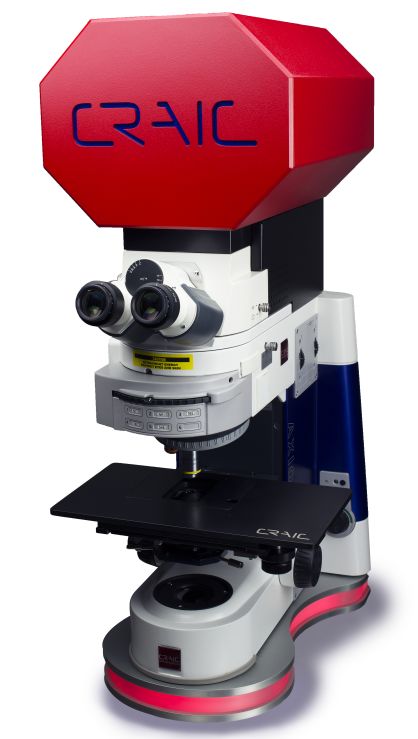
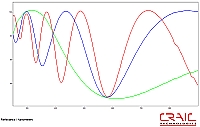
Typical test spectra from for thin film thickness
Industries that use film thickness measurements include:
- Optics
- Semiconductor
- Films on stents
- and much more....
Small spot thin film thickness measurement can be done both by transmission and reflectance..
Thin film thickness measurement is done to monitor the thickness of thin films for a number of reasons. These include such diverse industries as semiconductor integrated circuit manufacturing, anti-reflective coatings on optics, protective coatings and many more. In all of these cases, it is critical to have consistent thickness of the films that are being deposited on the surface. This can be done by acquiring the transmission or reflectance spectrum of a microscopically small area and calculating the thickness of the film. This can be done for many locations on the item to map the changes in film thickness across the surface.
The CRAIC Technologies™ microspectrophotometer tools allow for non-destructive and non-contact thin film thickness measurement of sub-micron sized areas in both reflectance and transmittance. CRAIC instruments can also measure polarization anisotropy, optical emissions and even fluorescence. These flexible tools are equally at home in the R&D laboratory, the fab floor or the failure analysis facility. Currently, CRAIC solutions are used for film thickness measurement of semiconductors, LCD displays, OLED's, and optical products.
To learn more about thin film thickness measurement and how microspectrophotometers do it, select one of the following links:
Thin Film Thickness Measurement Science
Adding spectroscopy to your microscope!
As shown in the diagram on the right, the MSP head unit can be added to the photoport of a microscope, and the spectrometer measures the light that is collected by the objective and focused onto the spectrophotometer entrance aperture. Whether this light is transmitted through the sample, reflected from the sample, or emitted by the sample, that only changes the calculations done on the light intensity measured.
Beyond just measuring UV-VIS-NIR spectra with microscale sampling areas, the microspectrometer are also capable of microspot thin film thickness and colorimetry measurements. When combined with motorized stages, hyperspectral data cubes can even be created with various types of spectra. Because these instruments are so flexible, MSP's are used in many diverse fields of research and industry.
Microfluorometer
The microfluorometer measures the UV-visible-NIR fluorescence spectra of microscopic samples.
The Microfluorometer is a fluorescence spectrophotometer combined with a microscope. They are designed to measure fluorescence spectra of microscopic samples or microscopic areas of larger objects. There are two basic types: the fully integrated microfluorometer that has been built and optimized for fluorescence microspectroscopy and the fluorescence spectrometer unit designed to attach to an open photoport of an optical microscope. The beauty of microfluorometers is that they can also be configured to measure the transmission and reflectance spectra of microscopic sample areas in addition to fluorescence. And with special software, they are capable of colorimetry as well.
A CRAIC Technologies™ microfluorometer is a purpose-built system that allows you to analyze UV-visible-NIR range fluorescence microspectra™ non-destructively and with no sample contact. Capable of analyzing even sub-micron areas, they are also capable of high resolution digital imaging. Designed for ease-of-use, they are durable instruments designed for microscale spectroscopy.
To learn more about microspectroscopy and microfluorometers, select one of the following links:

